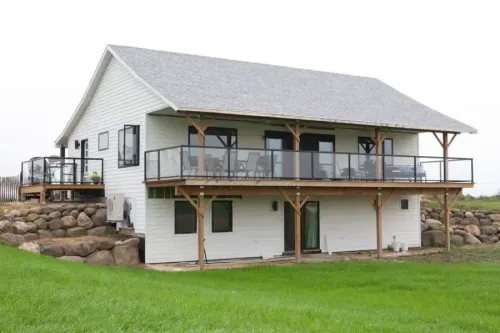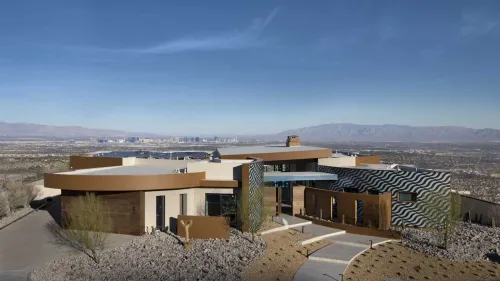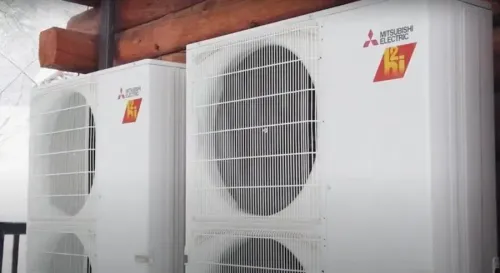Project Location: Oklahoma City, Oklahoma
Completion Date: May 2016
Challenge
Complementing modern architecture and providing efficient cooling and heating for diverse spaces across five separate buildingsSolution
Mitsubishi Electric VRFResult
A campus with a stunning look and year-round occupant comfort
In the early 2000s, the Oklahoma River was dammed up as part of the MAPS1 community improvement initiative. The project not only accomplished its goal, but set the stage for a vibrant riverside filled with attractions and stunning architecture. The Oklahoma City (Okc) Boathouse District is central to that vibrancy, with six buildings offering athletic training facilities, event spaces, activities for children and adults, and more. With such a wide range of cooling and heating needs across its six buildings, it’s no surprise that the five newest Boathouse District buildings use Variable Refrigerant Flow (VRF) from Mitsubishi Electric.
John Riggs, senior director of operations, Okc Boathouse Foundation, assists with all construction projects on campus and oversees the maintenance of the facilities and grounds. He described the Devon Boathouse – the first building completed with Mitsubishi Electric VRF – as a “stunning, high-performance facility, and a designated U.S. Olympic & Paralympic Training Site. There’s a little bit of everything across its 33,000 square feet: a dynamic rowing tank; a gym with a freeweight area, kayak ergometers and treadmills; locker rooms; an event room that holds 200 people seated; an endless pool; a high-altitude chamber; and multiple boat bays.”
A facility with so many spaces, and with each space dedicated to occupant experience, required an HVAC system with advanced controls. “This is about access – the ability to remote in and change things on the fly. A high level of access and control means you can manage energy costs and customers’ comfort. VRF offers that kind of access,” said Riggs.
VRF was also extremely flexible and discreet in its design. The Devon Boathouse features glass and polycarbonate walls to create an open feel. To match that aesthetic, the HVAC system’s indoor and outdoor units both needed to be unobtrusive. Riggs said, “We couldn’t have anything on the roof – that’s just how it is on the whole campus. Nothing on the roofs. Everything’s gotta be straight lines. And all of the buildings on campus are triangles, so they have this crisp, clean look. We needed a system that could match that.”
Damon McClure serves as the project manager for the Boathouse District’s mechanical contractor, Harrison-Orr Air Conditioning, Llc, Oklahoma City. “Most of the HVAC selection at Devon was definitely about achieving a discreet look. Trying to hide everything with a four-pipe system with a boiler, for example, would have been very hard. At the same time, energy efficiency was important. There are event rooms that need to be heated, and also training rooms that need to be kept at 66 degrees all the time – receiving cooling even in the winter. Devon needed a system that would make economical use of consumed energy. Heat pumps with heat recovery offered the ability to zone properly given the diversity of the space.”
With VRF identified as the preferred technology, the team then decided on Mitsubishi Electric for “the support. They’re always doing upgrades. They won’t leave you behind,” said Riggs. McClure added, “Mitsubishi Electric products are great. We’ve done almost 3,000 tons of Mitsubishi Electric; I believe in them so much I have them in my home.”
Riggs said the installation process for Mitsubishi Electric VRF is “pretty quick. The condenser units go in good and clean, and the flexibility of the indoor units has let us do some unique things, like taking out soffits and putting units in there.” McClure has also been impressed with Mitsubishi Electric’s training offerings: “We sent several of our guys to a training class in Texas a few months before doing the Devon Boathouse. The hands-on training is invaluable when working with VRF.” For Riggs as an end-user, no specific training was needed: “The system was simple to learn, in terms of using the controls. And the controls have been effective.”
After such a positive experience, the campus continued using Mitsubishi Electric VRF on other projects. The next was the Chesapeake Finish Line Tower, or what McClure described as “a unique cantilevered building – unique in terms of look and structure. It’s shaped like a triangle with five floors and a basement, and each floor is cantilevered off of the main structure. It has castellated beams, so we worked with the engineer to find a path for the ductwork through the beams’ holes. We also concealed the indoor units above the ceiling.”
The tower’s outdoor units also required a creative solution since “the architect didn’t want the outdoor units to be visible. So we put them in the basement. They pull in natural outside air ventilation. In the winter they reject heat into the basement, and in the summer they reject heat outside – all to keep the equipment running at peak efficiency,” said McClure.
The Chk|Central Boathouse was designed and built next. It features a performing arts venue, art gallery and workout center. Like the Devon Boathouse, the Chk|Central Boathouse created the HVAC challenge of having a big variety of heating loads and unique spaces. McClure said, “A range like that can only be done with this kind of system. So we did four Mitsubishi Electric VRF systems for this boathouse. One is a straight heat pump – so, no heat recovery. That’s for the performing arts venue. The load in that space varies a lot, so we needed a system that could ramp up when there were lots of people there, and then ramp down when there was no performance going on. That space also had to be acoustically sound.”
After the second boathouse, the project team began yet another project: the SandRidge Youth Pavilion. The pavilion is a smaller space, coming in at 2,000 square feet, and serves as a space for concessions, retail and sports activities. To match the Boathouse District’s general look, the pavilion is a triangular building. Tom Berkeley is the project manager at Lingo Construction Services, Oklahoma City – the general contractor for several of the campus projects. He said, “With SandRidge, we wanted to maintain the design integrity – the high-level, contemporary look – by hiding the HVAC. We didn’t want to see ductwork, and wanted the ceilings to be as tall as they could be.”
He continued, “Our other big HVAC concern, of course, was the people load. You’ll get 10,000 people in the area on a busy weekend, and many will go through the building. It could be 100 degrees outside with people coming in and out of the building, so keeping people comfortable was a big concern.” Comfort has not been an issue, though. Berkeley said, “We haven’t had any problems. Everything is good; the Mitsubishi Electric system is doing exactly what we wanted it to do.”
The most recent project, Riversport Rapids, matches the other buildings in architectural beauty and HVAC challenge. McClure said, “This building is a lot bigger than the others. It has a large restaurant, a pro shop, a locker room, a big kitchen and a large seating area… and then cubicles, offices, It closets and warehousing. So it’s not just a large building, it has all sorts of spaces.” The project team installed four Mitsubishi Electric VRF systems, concealing the outdoor units “behind a mechanical screen where you can’t see them.” As with the other projects, it could have been difficult to find an HVAC solution that looks and sounds discreet, and that ensures comfort across a variety of spaces and loads. With Mitsubishi Electric, this was not a problem. McClure said, “I think of this as an architectural feat – especially since it’s a high-performance building.”
Riggs echoed that sentiment for the overall Boathouse District project: “Working with the Mitsubishi Electric systems has been great. They’re unlike any other systems, and they’re fantastic. Very usable.” That usability goes a long way. The Boathouse District has become a hugely popular area destination. It’s no wonder: its beautiful buildings offer spaces to train Olympians, take in a show, do recreational or sporting activities, or just sit back and enjoy a nice, comfortable afternoon.
Click here to learn more about Boathouse District and hear directly from the project team.
Project Team
- Mechanical Contractor: Harrison-Orr Air Conditioning, Llc, Oklahoma City, Oklahoma
- General Contractor: Chk|Central Boathouse, SandRidge Youth Pavillion: Lingo Construction Services, Oklahoma City
- Devon Boathouse: Timberlake Construction, Oklahoma City
- Chesapeake Finish Line Tower: Smith & Pickel Construction, Oklahoma City
- Riversport Rapids: Downey Contracting, Llc, Oklahoma City
- Engineer: Determan Scheirman Engineering, Oklahoma City
- Architect: Elliott + Associates Architects, Oklahoma City
Equipment Installed
Riversport Rapids:
- (8) PURY R-2 Series Outdoor Units
- (25) PEFY Ceiling-Concealed Ducted Indoor Units
- (3) PFFY Floor-Standing Exposed Indoor Units
- (1) PLFY 4-Way Ceiling-Recessed Cassette Indoor Unit
- (2) PVFY Concealed Vertical Ducted Indoor Unit
SandRidge Youth Pavillion:
- (1) PURY R2-Series Outdoor Unit
- (6) PEFY Ceiling-Concealed Ducted Indoor Units
- (1) PLFY 4-Way Ceiling-Recessed Cassette Indoor Unit
- (2) Lgh Lossnay Energy Recovery Ventilators
Chk | Central Boathouse:
- (4) PURY R2-Series Outdoor Units
- (3) PUHY Y-Series Outdoor Units
- (15) PEFY Ceiling-Concealed Ducted Indoor Units
- (5) PLFY 4-Way Ceiling-Recessed Cassette Indoor Units
- (9) PVFY Concealed Vertical Ducted Indoor Units
Chesapeake Finish Line Tower:
- (6) PURY R2-Series Outdoor Units
- (29) PEFY Ceiling-Concealed Ducted Indoor Units
- (2) PKFY Wall-Mounted Indoor Units
- (2) PMFY 1-Way Ceiling-Recessed Cassette Indoor Units
Devon Boathouse:
- (8) PURY R2-Series Outdoor Units
- (21) PEFY Ceiling-Concealed Ducted Indoor Units
- (1) PKFY Wall-Mounted Indoor Unit
- (33) PLFY Ceiling-Recessed Indoor Units
- (15) Lgh Lossnay Energy Recovery Ventilators









